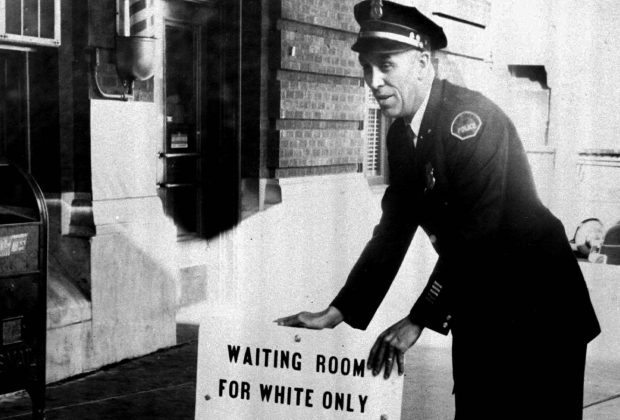
Trump's "Deportation Force" and the 1930s Mexican Repatriation Era
By: Armando Vazquez-Ramos and Lidieth Arevalo, "El Magonista" Newsletter ~ Feb. 22, 2017
During his presidential campaign, Donald Trump repeatedly proposed an immigration reform that would include building a wall on the U.S.-Mexican border, paid for by Mexico, and called for the mass deportation of immigrants who are in the U.S. illegally.
As promised, President Trump is already implementing his threat to create a gestapo-like "deportation force" to carry out massive deportations, which would target primarily Latinos, as it was the case during the 8 years of the Obama Administration when 96% of the 3 million deported immigrants were Latinos, and primarily of Mexican origin.
Trump's deportation plan echoes a largely forgotten and unknown chapter of U.S. history, when in the 1930's during the Great Depression, about 2 million people of Mexican descent were deported or pressured to leave the U.S . across the border into Mexico, as part of President Herbert Hoover's Mexican Repatriation Program . It wasn't called deportation. It was euphemistically referred to as "repatriation", but even though the term is inaccurate, approximately 60% of those deported or driven out were U.S. citizens of Mexican descent.
The Repatriation Act of 1930 is not widely discussed in American history textbooks and a 2006 survey found that of the nine most commonly used American history textbooks in the United States, four did not mention the Repatriation era, and only one devoted more than half a page to the topic. (We recommend reading "Decade of Betrayal: Mexican Repatriation In the 1930's", INS Records for 1930s Mexican Repatriations, and also watch "A Forgotten Injustice" to learn more about the Mexican Repatriation Era).
Although later considered unconstitutional, the Mexican Repatriation Program was legislated by the U.S. Congress and implemented by U.S. federal, state and local government authorities, largely enforced without due process and grossly violated U.S. citizens' civil rights.
According to professor Vicky Ruiz, the Immigration and Naturalization Service targeted Mexicans because of "the proximity of the Mexican border, the physical distinctiveness of mestizos, and easily identifiable barrios", targeting areas with large Mexican populations, mostly in California, Texas, Colorado, Illinois and Michigan.
With this background, undoubtedly history is repeating itself as Latino immigrants in the U.S. become today's scapegoat as Jews were in fascist Germany in the 1930's, resonated by the following Op-Ed by James Q. Whitman in today's Los Angeles Times:
By James Q. Whitman, L.A. Times Op-Ed ~ February 22, 2017
The European far right sees much to admire in the United States, with political leaders such as Marine le Pen of France and Geert Wilders of the Netherlands celebrating events - such as the recent presidential election - that seem to bode well for their brand of ethno-nationalism. Is this cross-Atlantic bond unprecedented? A sharp break with the past? If it seems so, that's only because we rarely acknowledge America's place in the extremist vanguard - its history as a model, even, for the very worst European excesses.
In the late 1920s, Adolf Hitler declared in "Mein Kampf" that America was the "one state" making progress toward the creation of a healthy race-based order. He had in mind U.S. immigration law, which featured a quota system designed, as Nazi lawyers observed, to preserve the dominance of "Nordic" blood in the United States.
The American commitment to putting race at the center of immigration policy reached back to the Naturalization Act of 1790, which opened citizenship to " any alien, being a free white person." But immigration was only part of what made the U.S. a world leader in racist law in the age of Hitler.
Then as now, the U.S. was the home of a uniquely bold and creative legal culture, and it was harnessed in the service of white supremacy. Legislators crafted anti-miscegenation statutes in 30 states, some of which threatened severe criminal punishment for interracial marriage. And they developed American racial classifications, some of which deemed any person with even "one drop" of black blood to belong to the disfavored race. Widely denied the right to vote through clever devices like literacy tests, blacks were de facto second-class citizens. American lawyers also invented new forms of de jure second-class citizenship for Filipinos, Puerto Ricans and more.
European racists followed these toxic innovations with keen interest. Of course they were well aware that America had strong egalitarian traditions, and many of them predicted that American race law would prove inadequate to stem the rising tide of race-mixing. Hitler, however, was cautiously hopeful about America's future as a white supremacist state, and after he took power in 1933 his Nazi Party displayed the same attitude.
This is the background to a disturbing story: the story of the American influence on the Nuremberg Laws, the notorious anti-Jewish legislation proclaimed amid the pageantry of the Nazi Party Rally at Nuremberg in September of 1935.
At a crucial 1934 planning meeting for the Nuremberg system, the Minister of Justice presented a memorandum on American law. According to a transcript, he led a detailed discussion of miscegenation statutes from all over the United States. Moreover, it is clear that the most radical Nazis were the most eager advocates of American practices. Roland Freisler, who would become president of the Nazi People's Court, declared that American jurisprudence "would suit us perfectly."
And the ugly irony is that when the Nazis rejected American law, it was often because they found it too harsh. For example, Nazi observers shuddered at the "human hardness" of the "one drop" rule, which classified people "of predominantly white appearance" as blacks. To them, American racism was sometimes simply too inhumane.
That may sound implausible - too awful to believe - but in their early years in power, the Nazis were not yet contemplating " The Final Solution." At first, they had a different fate in mind for the German Jewry: Jews were to be reduced to second-class citizenship and punished criminally if they sought to marry or engage in sexual contact with "Aryans." The ultimate goal was to terrify Germany's Jews into emigrating.
And for that program, America offered the obvious model - even if, as one Nazi lawyer put it in 1936, the Americans had "so far" not persecuted their Jews. Of course the Nazis did not simply do a cut-and-paste job, in part because much of American law avoided open racism. (Laws intended to keep blacks from the polls did not explicitly name their target.) But American antimiscegenation law was frankly racist, and the Nazi criminalization of intermarriage followed the American lead.
In a sense, this ugly tale about the history of American racism is also about American innovation gone awry. Today, we're leaders in the creation of corporate law; back then, it was race law. Other countries, such as Australia, put legislative obstacles in the way of mixed marriages, but the United States went so far as to threaten long prison terms.
And we must not forget how tenaciously the racist rulebook that the Nazis admired held on in the United States. Antimiscegenation laws were only struck down at the tail end of the civil rights era, in 1967. Race-based immigration policies did not fully end until 1968 - long after the Greatest Generation stormed the beaches of Normandy and liberated Nazi death camps.
"A Forgotten Injustice" is the first and only documentary about the illegal and unconstitutional deportation of almost 2 million U.S. citizens and legal residents during the 1930s. The vast majority of the deportees were U.S citizens of Mexican descent.
During the 1930's, Mexicans (Back then Mexican was a label given based on the color of the skin and not on the place of birth or legal status) were identified as the enemy and some government officials came up with a banner: "American Jobs for Real Americans." All of the sudden, Mexicans were "responsible" for the economic problems of the nation and the government came up with a solution: Deport as many Mexicans, not foreigners in general, only Mexicans.






